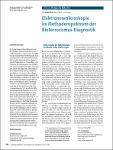Elektronenmikroskopie im Methodenspektrum der Bioterrorismus-Diagnostik
Electron microscopy in diagnosis of bioterrorism agents
Gelderblom, Hans R.
Die Erregerdiagnostik bei Bioterrorismus- (BT-)Verdacht gewinnt durch den Einsatz visueller Verfahren an Präzision und Schnelligkeit. Die resultierende morphologische Diagnostik am Licht- und Elektronenmikroskop (EM) erfordert keine spezifischen Reagenzien; die Präparation von Proben direkt vom Patienten, aus der diagnostischen Zellkultur oder aus BT-Umweltproben selbst ist einfach und schnell. Die Präparation, überwiegend durch Negativkontrastierung, ermöglicht innerhalb von 15 min durch den „offenen Blick“ die schnelle Visualisierung aller in der Probe enthaltenen Strukturen. Die Auflösung des EM reicht zur Erkennung auch kleinster Viren. Die EM-Diagnose gibt so eindeutig Hinweis auf die vorliegende Virusfamilie, nicht aber auf den spezifischen Typ. Diese „Gruppendiagnose“, z.B. als schnelle Differenzialdiagnose bei Pockenverdacht, reicht dem Kliniker oder Epidemiologen häufig schon für das weitere Handeln.Im Labor führt sie orientierend und frühzeitig zur Ausrichtung der Differenzialdiagnostik auf die relevanten Keime in der Probe.Die Vorteile der EM in der BT-Diagnostik sind nicht nur für die Diagnostik von Viren hilfreich, sondern, wie die Erfahrungen mit der Anthraxdiagnostik in den USA und bei uns gezeigt haben, auch von bakteriellen Erregern. Die Sicherheit für das Laborpersonal kann durch vorhergehende Probeninaktivierung erreicht werden.Zur Sicherung der Qualität der morphologischen Erregerdiagnostik werden vom Konsiliarlaboratorium entsprechende Ringversuche und Laborkurse veranstaltet. In case of a suspected attack diagnostic light and electron microscopy (EM) aids in the laboratory diagnosis of potential bioterrorism disease agents (BT agents) .Morphological details of a suspected structure provide evidence for rapid and precise diagnosis of the underlying agent. Sample preparation directly from a patient, a diagnostic culture, or from environmental samples relies mainly on negative staining, does not require specific reagents, and can be performed within a few minutes. By its "open view" EM is a catch all method, i. e., by the intrinsic resolution of EM even the smallest viruses become detectable as well as multiple infections and even agents that were not considered before. The morpho-diagnosis reveals just the virus family, not the specific type. This group diagnosis can provide a rapid and specific answer, e. g., in the differential diagnosis (DD) between smallpox and chickenpox. Diagnostic EM can be applied with advantage to visualize also bacterial BT agents, e. g., the anthrax letters in the USA and Germany. It also helps to focus laboratory DD on the relevant family of agents. Safety of lab personnel is accomplished by prefixation of diagnostic samples, while quality is controlled by participation in external quality assurance schemes and lab courses performed by the Consultant Lab for Diagnostic EM.
Dateien zu dieser Publikation
Keine Lizenzangabe

